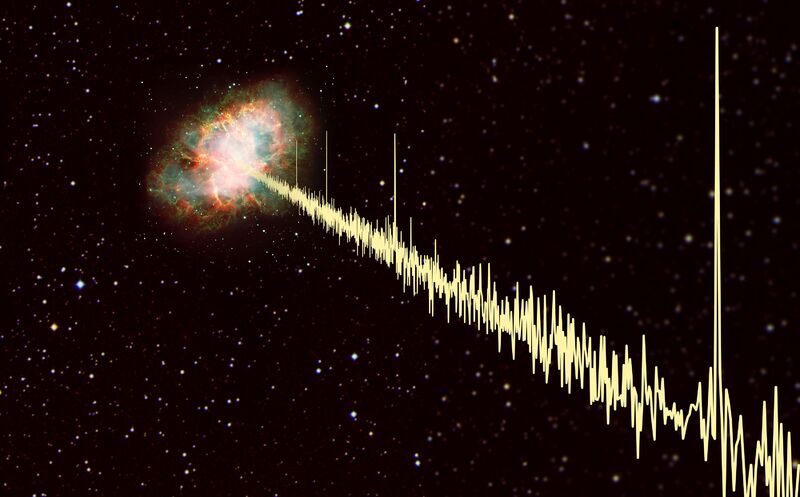The Crab Pulsar and Nebula
Description
The Crab Pulsar and the Crab Nebula are one impressive pair, especially in this unique image made by a duo of NRAO radio telescopes. The Nebula was formed when the original star exploded: this 'supernova' explosion was so bright that in 1054 A.D it was visible in the daytime for several weeks. In the centuries that followed the remnant kept expanding. Then, in 1968, another product of the supernova was found, an object that turned out to be the engine powering the bright remnant: the Crab Pulsar. As the outer layers of the original star were ejected in the supernova, the entire core must have collapsed to form a pulsing neutron star or 'pulsar', one of the densest objects we know of in the entire galaxy. Only 10 miles across but 500.000 times as massive as the Earth, this cosmic lighthouse spins 30 times each second, sweeping around bundles of bright radio waves. In this image we see a 1-second snapshot of these peaked waves as they reach the NRAO Green Bank Telescope after 6000 years of interstellar travel. In the background the still expanding Nebula shines on, with a red glow captured by the NRAO Very Large Array and blue and green light seen by ESO's VLT.
The Crab Pulsar data were taken with the NRAO Green Bank Telescope on July 10, 2004 by Scott Ransom from the National Radio Astronomy Observatory. The pulsar was observed over the 820-870 MHz RF1 frequency range, with the Spigot pulsar back end recording 1024 spectral channels every 81.92 microseconds. For this image, interstellar dispersion was removed from the data and the dynamic range was adjusted to scale the first four giant pulses. About 1 second of data is shown in the total pulse train. The Crab Nebula was observed in the radio by Michael Bietenholz (Hartebeesthoek Radio Astronomy Observatory and York University) on March 12, 2001, with the NRAO Very Large Array in C-band using the B, C and D configurations. The data were represented as a false-color level-adjusted red band for the Nebula. The green and blue bands shown for the Crab Nebula are R and B-band ESO VLT FORS2 images taken on November 10, 1999. For the background field the DSS2 IR,R and B bands were aligned and converted to red, green and blue respectively. Color levels were adjusted to match background color for the composite Nebula image and the pixels were interpolated 5x in each dimension to match the VLT resolution. Finally the right-hand side of the field was progressively blurred to suggest depth.
Creator
Legacy Astronomical Images
Rights
NRAO/AUI/NSF does not hold full copyright for this image. Contact the archivist for details.
Type
Legacy Astronomical Image
Object Name
PSR B0531+21
Photo Credit
Joeri van Leeuwen (UC Berkeley) / ESO / AURA
Investigators
Joeri van Leeuwen (UC Berkeley), Scott Ransom (NRAO), Michael Bietenholz (HartRAO & York U)
Telescope
Green Bank Telescope (GBT)
Very Large Array (VLA)
Observation Date
2004-07-10
Type of Observation
continuum
Center of Image
RA 5:34:10.000, Dec: 21:59:0.000 (J2000)
Field of View
0.416667 x 0.250000 degrees
Notes
Contact the archivist for a high resolution tif of this image.
Series
Galactic Sources Series
Unit
Pulsars/Neutron Stars Unit
Citation
Legacy Astronomical Images, “The Crab Pulsar and Nebula,” NRAO/AUI Archives, accessed June 14, 2025, https://www.nrao.edu/archives/items/show/33474.

